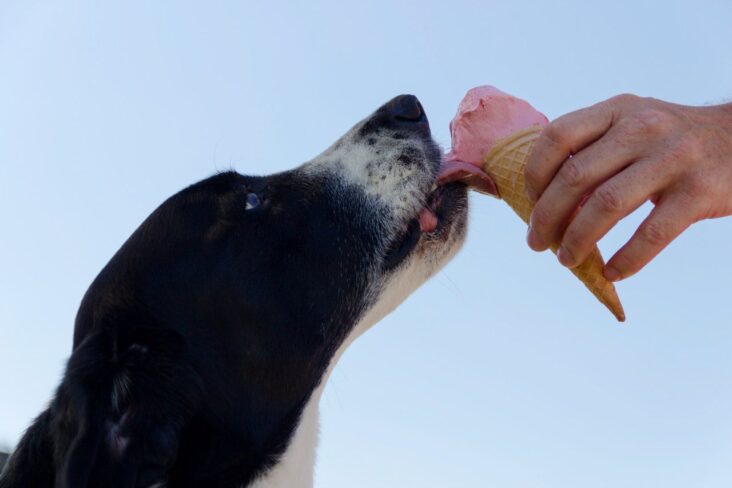As man’s best friend, dogs do everything with us: walk around town, ride in the car, play in the yard, and snuggle on the couch. It’s natural, then—given how much time we spend with our four-legged companions—to assume they can eat with us, too. However, human food can be dangerous for dogs, even types of food that are completely safe for us.
Part of the reason we can eat foods that they can’t is that dogs are so much smaller than us. They also weigh far less, which means their bodies can’t absorb things as quickly. “Foods that are perfectly suitable for human consumption, as well as other animals, may be toxic and even poisonous to your dog, posing a serious threat to their health and well-being. Why? Because all animals have very different rates of metabolism.
1)Yeast
Eating unbaked bread dough can be extremely dangerous for your dog because the fermenting yeast gets rapidly absorbed in the bloodstream, where it produces enough ethanol to cause alcohol poisoning. Additionally, yeast dough can rise as it moves through the digestive system, potentially twisting the stomach—a situation that can lead to death. Even if the yeast doesn’t cause a life-threatening emergency, it can severely bloat your pup’s stomach, causing intense pain and discomfort.
2) Chocolate
Most people know that chocolate is bad for dogs. The problem in chocolate is theobromine. It’s in all kinds of chocolate, even white chocolate. The most dangerous types are dark chocolate and unsweetened baking chocolate. Chocolate can cause a dog to vomit and have diarrhoea. It can also cause heart problems, tremors, seizures, and death.
3) Avocados
Avocados contain a toxin called persin, which is perfectly safe for human consumption but can be very poisonous to dogs.
It is found in avocado fruit, pits, leaves, and bark, so you should avoid giving any part of the plant to your dog.
If a dog eats these, fluid may accumulate in the dog’s lungs and chest. This can make it difficult for them to breathe, which can lead to oxygen deprivation and even death.
Fluid can also accumulate in the heart, pancreas, and abdomen, and this can lead to other fatal complications.
Additionally, a dog can accidentally swallow an avocado pit, which can cause choking or a blockage in the digestive tract.
4) Garlic
Garlic is an allium, a family of foods that can be fatal to dogs due to a compound called thiosulfate that damages red blood cells. It takes a lot of garlic to cause toxicity but some breeds, particularly Japanese ones (such as Akitas and Shiba Inus), are particularly susceptible. Signs of garlic poisoning can be delayed and not apparent for several days. While tiny amounts of these foods in some pets, especially dogs, may be safe, large amounts can be very toxic.”
5 RAW EGGS
No doubt, eggs are full of protein and, if cooked well, can really benefit your dog’s coat and digestive system. But one way they are not great is if you give eggs to them raw. Never mind not great; it’s completely toxic!
The reason for this is that raw eggs can contribute to a biotin deficiency. Eggs contain an enzyme known as ‘avidin,’ which restricts the absorption of biotin, one of the many B Vitamins.
Even though biotin deficiencies are not that common in dogs, they could potentially still happen. If they end up having a biotin deficiency, they can be at risk of having an unhealthy coat, difficulty with digestion, skin problems and more. Not forgetting eggs can also carry salmonella, which is highly poisonous to dogs.
6) Grapes and Raisins
Responsible for the deaths of several dogs, grapes and or raisins in as little as 9-ounce quantities have proven lethal. Slightly more fortunate animals may experience kidney damage, requiring emergency medical care, but ultimately survive.
A few very lucky dogs may have no symptoms at all, but since the reason why grapes in their various forms (fresh, dried, fermented) are fatal to some is yet unknown, caution must be taken even if an animal has eaten grapes in the past without incident. This is because toxins may be capable of building up over time and reaching dangerous levels only gradually; a small grape-containing snack here and there may not be problematic on its own, but in combination may prove lethal.
If dogs eat a large number of grapes or raisins, it is recommended that they are induced to vomit, have their stomachs pumped, and are given activated charcoal and IV fluids.
Like dogs, cats can be asymptomatic or else can experience serious kidney damage if fed raisins or grapes.
7) Alcohol
Alcohol is found in a variety of products, including alcoholic beverages, perfumes, mouthwash, paint, varnish, and various cleaning products.
While occasional alcohol consumption is safe for humans, dogs cannot tolerate it, even in small amounts.
Symptoms usually develop within an hour after consumption and include tiredness, depression, lack of muscle coordination, low body temperature, poor breathing, vomiting, and diarrhoea.
If a dog consumes too much alcohol, it can result in lung failure, seizures, coma, and even death.
Alcohol poisoning in dogs usually happens after accidental ingestion of alcoholic beverages.
It’s also a concern if a dog eats raw dough that contains yeast. As the yeast cells ferment, they actually produce alcohol, which causes a dog’s blood-alcohol level to rise and can ultimately cause alcohol poisoning and death.
What’s more, the dough will expand in a dog’s stomach and can cause severe bloating. This puts pressure on the surrounding organs and can make it very difficult for the dog to breathe.
It is important never to feed raw yeast dough or alcohol to your dog. Alcoholic beverages should not be left unattended, and the raw dough should be kept well out of reach.
8) Cooked Bones
The most common and frequent dog treat is, without a doubt, bones, although most dogs cannot safely consume cooked bones since they can splinter or get lodged in the throat or intestinal tract, requiring surgeries and can even cause death. Raw bones are less likely to splinter, but the risk is still there, and they may contain bacteria that cause digestive distress.
Admittedly, this subject is controversial. There is a lot of evidence to support both the benefits and risks. Some owners will not stop giving their dogs bones, believing the pros outweigh the cons. Annually, thousands of dogs end up in emergency care as a result.
All bones are considered risky, including chicken, pork, and beef. Chicken bones are especially likely to get swallowed whole or only partially chewed, which can lead to intestinal perforation. The next time you feel the need to toss the dog a bone, try tossing a rawhide bone instead. Your dog will thank you for many happy, healthy years to come.
9) Apple Cores
Cyanide poisoning can result from giving your dog the apple core from your afternoon snack. The pits and cores of certain fruits—plums, peaches, pears, apricots, and apple cores—may be fun to chew on but hide cyanogenic glycosides, better known as cyanide. When your dog munches on these seemingly harmless treats, he also ingests the toxin.
Some of the symptoms of toxicity are apprehension, dilated pupils, salivation, struggling to breath, dizziness, collapse, seizures, hyperventilation, shock, and coma.
10 Milk, Cheese, Ice Cream, And Other Dairy Products
You may have slipped your dog a pill in a piece of cheese, but dogs aren’t really built to process cow milk products. They lack the enzyme to break down milk sugar, and while some dogs are more able to handle dairy than others, many dogs are lactose intolerant. Dairy can cause dogs to vomit, have diarrhoea, or develop gastrointestinal diseases. The high-fat content can lead to pancreatitis, as is the case with fatty meats. Don’t share your dairy with your dog. More ice cream for you!
11) Raw Meat& Fish
his one is a subject of controversy, as many vets are seeing health benefits from their patients switching to raw meat diets, including healthier skin and coats, cleaner teeth, and easier digestion. Some veterans recommend cooking raw food to kill off bacteria and parasites that can be harmful to dogs. The majority of veterans still discourage feeding raw meat to dogs, and salmonella and e. coli infections do happen in canines. Most of these infections happen to dogs whose immune systems are already compromised, but it may be hard to tell if your dog’s immune system is completely healthy.
Raw eggs have enzymes that can cause skin conditions in dogs, and raw fish can hide parasites that cause fatal diseases. There are risks to a raw diet that you need to weigh against the benefits before you decide to try it. These risks can be reduced through freezing and proper preparation, but you need to learn how to properly handle raw food before you feed it to your dog.
The important thing to understand is that it is absolutely not safe to just run to the grocery store, buy raw meat, and toss it into your dog’s bowl or to allow your dog to sneak unprepared meat off the counter or out of the garbage. If you are planning to switch to a raw diet for your dog, you need to learn about the proper preparation of the food so that the risk of bacterial or parasitic infection can be minimized, learn about the appropriate amount to feed your dog and take into account your dog’s overall health. Research and understand the risks and stay informed. If you don’t, your dog can get very
12) Onions
Cooked or raw, onions contain thiosulphate, a substance that causes your dog’s red blood cells to burst in a condition called hemolytic anaemia. Symptoms include diarrhoea, vomiting, breathlessness, and lethargy; it could take two to four days for them to become noticeable. You also put your dog at risk if you give her certain foods that are made with onions, like pizza or tomato sauce, which could trigger the same reaction.
13) Caffeine
No idea who would ever share coffee with a dog. I mean, what do they have to do all day other than sleep and look out the window? In all seriousness, owners should never let their dogs near the coffee or any form of caffeine.
Because coffee contains the stimulant caffeine, animals ingesting it may experience overexcited nervous systems.
The lethal amount of caffeine for both dogs and cats is 150 mg/kg body weight.
Dogs may react after coffee consumption with increases in breathing and heart rate, shaking, and muscle twitching. Cats consuming caffeine often experience diarrhoea and vomiting, a fast heartbeat, shaking uncontrollably, seizing and collapse.
Asymptomatic animal should be induced to vomit and receive activated charcoal.
14) Mushrooms
Mushrooms come in many varieties; some are highly toxic, while others are harmless.
Unless an owner is a mushroom expert and can tell the difference, a dog that has been suspected of eating mushrooms should be watched closely. (Mushrooms that sprout in backyards are usually toxic).
To be safe, it is recommended that the dog is induced to vomit and given activated charcoal if the mushroom is not expelled in its entirety. The wrong mushroom types can cause jaundice and liver damage, leading to internal bleeding or seizures, or can have hallucinogenic effects resulting in tremors, seizures, and coma.
If a dog vomits on its own or develops diarrhoea but lacks other symptoms, likely no serious harm has been done; however, if the gastrointestinal upset is accompanied by excess saliva or tears, reduced pupil size, slowed heartbeat, depressed activity or lethargy, restlessness, staggering, or a comatose and unresponsive pet, medical care is mandatory.
15) Walnuts
Black walnuts and English walnuts can lead to gastrointestinal problems or a possible intestinal obstruction in dogs; especially moldy black, English or Japanese walnuts have strong mycotoxins that cause seizures or other neurological abnormalities.
In horses, black walnuts can cause the vascular disease laminitis. This is due to the toxin they contain known as juglone, which is not problematic to dogs.
conclusion
Certain foods that are safe for humans, including the seven listed here, can be very harmful to dogs.
The best way to avoid food poisoning in dogs is to feed them only dog food and keep human foods out of reach.
If your dog has eaten something it should not have, contact your vet or call the pet poison hotline immediately.








GIPHY App Key not set. Please check settings